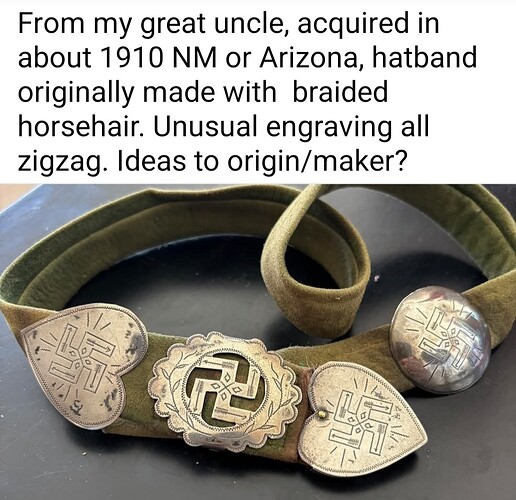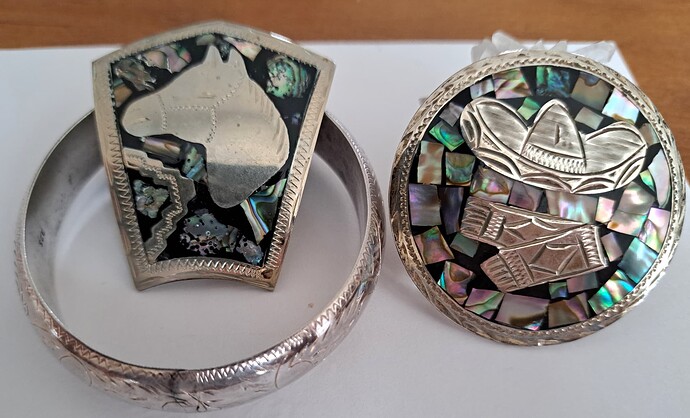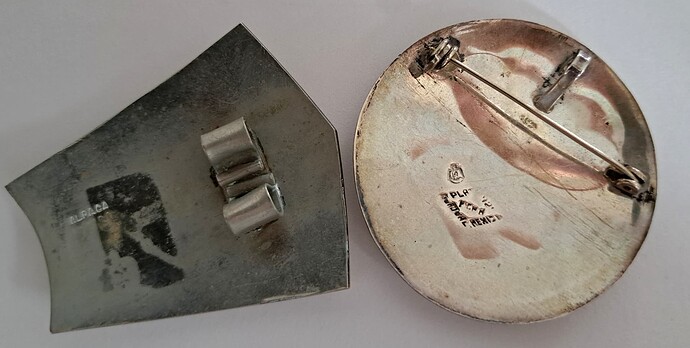I’m posting this because I may have a misperception about a design element. And, I want to learn. The 1st photo is from a site about Native American jewelry. The OP is inquiring about the unusual engraving, all zigzag. The comments community primarily discussed the Whirling Log/Third Reich symbol on the pieces. Some comments mentioned this item as being Navajo made, and nothing otherwise. Me: I’ve always considered this engraved zigzag design, around the perimeter, to be an indicator of Mexican jewelry and not Native American. (The 2nd & 3rd photos are my Mexican jewelry with a zigzag design element.) Am I incorrect in my attribution of this design element? Thanks for your input/insight.
You have Taxco Alpaca on both the brooch and the bolo slide. Nickel Silver or sometimes called German Silver. The pattern you are seeing are similar, but not enough on it’s own to determine origins. You can find examples of Taxco mimicking Native American patterns and styles. The eagle stamp that looks like a shield with a number inside indicates that it was made prior to 1980. Thats when the Mexican silversmiths started using the letter number system.
More about whirling logs can be found here.
The design work is all done in hand engraved “wriggle cut” which is a traditional western technique used in cowboy bright cut, and Mexican charro style engraving. Not a technique traditionally used in Navajo jewelry, but it wouldn’t rule out the use of the technique by a native silversmith skilled in the technique.
@mmrogers Thank you for this very helpful information! You’ve answered my question about the design element and, I learned a few things along the way. Much appreciated.
You do sometimes see very old Navajo jewelry with a zig zag pattern created by rocker engraving. As I understand, this technique was first used by plains metalsmiths, who were in many cases working in metal for adornment before the Navajo, though they usually worked in German or nickel silver. You do occasionally see rocker engraving on very old Navajo pieces as well, though. Here is an example that is attributed as Plains or Navajo:
I believe this might be rocker engraving in the hatband photo but am not quite sure. In any case it does not strike me as as old as 1910. (Rocker engraving has continued to be used, though somewhat rarely, in NA jewelry so I don’t think it’s presence is a clear indicator of any specific time period).
@chicfarmer thoughts?
@OrbitOrange Thank you for this information and the article you posted. It’s all very interesting. I really had no clue that this specific engraving form could possibly be Native American work.
Hi @OrbitOrange, while it looks like rocker engraving, I don’t associate that technique with Navajo-made tourist-era items, which this looks like. This design vocabulary wouldn’t have been for Indigenous wear; too cute.
I also question how old it is because of the overall busyness: heart shapes, arrows, diamonds, vine border (? odd). The shape of the central “concho” and its floral border especially, to me, seem a departure from Navajo work, even for the tourist trade. I think @mmrogers is on point in his assessment.
My pleasure, @Patina . The first portion of the following video demonstrates the technique for the ‘wriggle cut’ engraving used in the creation of your hatband.
Thank you for your insight on this hatband. The indicated age, “aquired in about 1910” for the item seems a bit suspect to me. Maybe this is just a segment of the hatband’s story that has evolved over the years🤷♀️. Those heart & vine motifs have a cutesy appeal to me, too.
I watched the entire video - it was fascinating! What a perfect example of “how to” wriggle cut. It looks exactly like the border on that hatband’s conchos & my Mexican jewelry. Thank you for taking the time to find this vid & sharing it.



